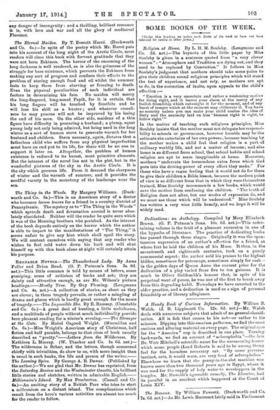The Eternal Maiden. By T. Everett Barre. (Duckworth and Co.
6s.)—In spite of the poetry which Mr. Barre puts into his account of the long night of the Arctic Circle, most readers will close this book with fervent gratitude that they were not born Eskimos. The horror of the oncoming of the long darkness is well rendered, as is also the grimness of the struggle for bare existence, which prevents the Eskimos from making any sort of progress and confines their efforts to the problem of storing enough food and oil whilst the summer lasts to keep them from starving or freezing to death. Even the physical peculiarities of each individual are factors in determining his fate. No maiden will marry the long-fingered, long-nosed Papik, for it is certain that his long fingers will be touched by frostbite and he will lose his skill as a hunter; and whatever comeli- ness lie may possess will not be improved by his losing the end of his nose. On the other side, maidens of a thin figure have difficulty in procuring a husband; a plump, squat young lady not only being admired, but being used in the long winter as a sort of human stove to generate warmth for her husband and children. Stern necessity, again, dictates that a fatherless child who suffers from any physical imperfection must have an end put to its life, for there will be no one to support it later on. Altogether, the problem of human existence is reduced to its barest, most primitive elements. But the interest of the novel lies not in the plot, but in the wonderful pictures of the sky in the Arctic Circle. It is the sky which governs life. From it descend the sharpness of winter and the warmth of summer, and it provides the needful variety in the monotony of the landscape near the sea.










































 Previous page
Previous page